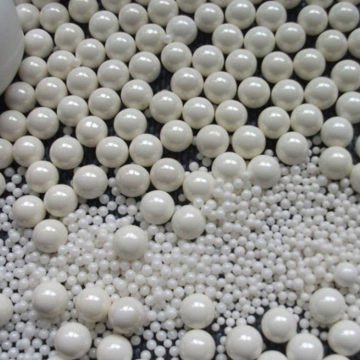Bead mill is grinding machines that have been used in coatings and other fields. However, in some cases, the grinding beads may be broken. The occurrence of this kind of accident can easily affect the quality of the product. This article will discuss how to solve the problem of fragile grinding beads.

If the machine is cleaned with a low-viscosity liquid, the beads will wear other beads or the contact parts of the bead mill. To obtain the longest service life of the grinding beads and sand mills, it is best to use resin for cleaning and maintain sufficient material viscosity during the production process.
First, identify the appearance of “broken beads”. If the particles are more round and not sharp (like broken glass pieces), they are naturally worn beads. These beads may be ground into various shapes such as discs, ellipses, or smaller spherical shapes. This is called abrasion, and the difference is only the degree of wear.
From the point of view of force, when the dispersion disc transfers energy to the beads, if the viscosity of the liquid is very low (for example, when cleaning the bead mill with solvent or water), the thrust of the material is not strong enough, and the beads are likely to contact the dispersion disc. Fragmentation occurs, which is also an important reason why we recommend shortening the cleaning time as much as possible.
If the machine is cleaned with a low-viscosity liquid, the beads will wear other beads or the contact parts of the bead mill. To obtain the longest service life of the grinding beads and bead mills, it is best to use resin for cleaning and maintain sufficient material viscosity during the production process.
Many people will encounter such a problem. Pour out the old beads from the sand mill and reload them with new beads for testing. The grinding beads are broken. The following will analyze this problem and discuss the solution.
The Internal Contacts of the Bead Mill are not Installed Correctly
If the dispersion disc is loose or the edge of the dispersion disc has sharp corners, there are foreign objects in the sand mill, and the valve is loose, etc., these conditions may cause the grinding beads to break.
The Contact Parts of the Bead Mill are Worn or Incorrectly Installed
The dynamic separator or the screen is worn, the screen is broken or installed backward, which will cause the grinding medium to pass through the separator and enter the feeding pump. This way, the beads will be crushed before the pump is blocked or shut down.
Backpressure
When the feed pump is turned off, the residual pressure in the bead mill presses the beads into the pump so that when the pump is started again, it will crush the beads. One-way valves are not necessarily reliable and sometimes allow beads to pass before the valve is closed.
Backlog of Grinding Beads
The accumulation of grinding beads at the bottom of the bead mill and the excessively high speed of the working pump will cause the grinding beads to concentrate at the outlet of the horizontal bead mill, which will cause the grinding beads to break. However, starting the bead mill with “on-off-on-off” jog mode to loosen the backlog of grinding beads, this situation will not occur.

Dispersion Disc Wear
Many reasons can cause this to happen, so the cause will be more difficult to determine. The edge of the dispersion disc is the place where the linear speed of the dispersion disc is the highest. If the edge of the dispersion disc is ground uneven, it is very likely to form a strong vortex. In addition, for a vertical grinder, the grinding beads are concentrated near the edge of the lower dispersion disc due to their weight.
The excessive wear of the dispersing disc is largely caused by the slow speed of the feed pump and the excessive density of the grinding beads. Generally speaking, we can solve this problem by replacing the severely worn parts and then loading the same batch of grinding beads.
Mix the Grinding Beads Produced by Different Manufacturers
Generally speaking, the density of products from different manufacturers is different. If the grinding beads produced by different manufacturers are mixed, the mutual wear between the beads will be aggravated.
Add the Used Old Beads to the Bead Mill
Doing so will also aggravate the mutual wear between the beads, thereby affecting their service life.
The Effect of Worn Beads
In actual production, there is often rubbish or some small worn beads attached to the screen, shaft, bracket, or other inner corners of the machine. When new grinding beads are added, these small things may loosen from the attachment position. It will be mixed into the newly added beads, which will cause the illusion that the new beads are also broken. If the effect is not significant, these small things can be discharged naturally after a certain period. Otherwise, the old beads must be completely discarded and replaced with new grinding beads.
The Way to Clean the Beads
The cleaning beads can be cleaned with water, solution, or resin according to the formula. When cleaning, the speed should be kept low, and the “start-off” button of the grinder should be pressed for intermittent cleaning.
Of course, if you need a high-quality sand mill, you can contact us. We are Allwin. We are a professional manufacturer of bead mill machinery. We can provide you with professional bead mills and complete bead mill maintenance solutions.